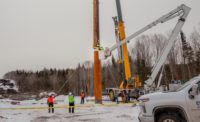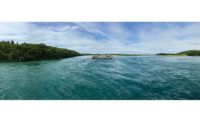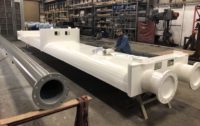At the mouth of the Bay of Fundy on the border between easternmost Maine and New Brunswick, Canada, Ocean Renewable Power Co. has been testing huge undersea turbines that the company claims eventually will generate low-cost tidal power from the tidal flow in Cobscook Bay for all of Downeast Maine.
Cobscook Bay lies west of the Bay of Fundy, one of the world’s most powerful energy resources, which functions as a big pump, says ORPC President Chris Sauer. “Each day, 100 billion tons of water flow in and out with the force of 8,000 locomotives and tidal ranges of up to 50 feet or more,” he says.
ORPC’s Maine Tidal Energy project is one of three demo projects chosen by the U.S. Dept. of Energy to integrate next-generation marine and hydrokinetic (MHK) technologies into system designs. Portland, Maine-based ORPC plans to run full-scale deployments over one year off Eastport and Lubec, Maine.
Sauer said the $5.3-million DOE grant, announced on Aug. 30, and matching private funding from foundations and other organizations will allow the company to complete the commercial design of the four-turbine TidGen Power System. The firm’s goal is to validate that the design improvements have hit targets to become the first unit of its 5-MW, 15-device system, he says.
In 2012, the Maine project was the first U.S. hydrokinetic power project to receive approval—from the Maine Public Utilities Commission—for a 20-year power purchase agreement. Moreover, it was the first MHK project in the Americas to send power to the (Emera Maine) grid.
The firm plans to complete final design and procurement by early next year, Sauer says, Benchmark testing is set for 2018 and 2019. ORPC plans to connect to the grid by late 2019 before build-out.
Royce Marine, a small division of Rolls Royce in Norway, will supply the system’s permanent magnet generator in 2018, Sauer says.
A total of $75 million in committed capital for the firm has funded 11 river and ocean projects since ORCP's inception in 2004, Sauer says. It also includes more than $41 million from government sources with the remainder from private investment. "The $5.3 million DOE award will provide significant funding towards the Maine project with an overall estimated cost of $10 million," he says.
ORPC has secured state and federal permits to conduct initial testing in Cobscook Bay. Then, work will move to the Western Passage, where the firm holds a preliminary FERC license, a company spokeswoman says. At Cobscook, the system is being tested in depths of 100 ft and, at the Western Passage, in the 150-ft to 400-ft range.
The DOE is awarding a total of $20 million to 10 organizations, including ORPC, to advance and monitor MHK energy systems that generate electricity from ocean waves and tidal currents.
With more than 50% of the U.S. population living within 50 miles of coastlines, the DOE recognizes the vast potential to provide clean, renewable electricity using wave and tidal energy.
The four-turbine TidGen system can be secured to the ocean floor by a fixed-bottom support frame or a buoyant-tensioned mooring system, ORPC states. The new system design features a buoyancy wing that can position the unit at optimum depths to take advantage of the strongest current.
The other two MHK DOE grant winners include Dresser-Rand, Wellsville, N.Y., which will integrate a 1-MW air-turbine power system into the Ocean-Energy oscillating water-column wave energy device, doubling the power output of the previous design; and Oscilla Power, Seattle, which will integrate advancements into its Triton wave-energy converter.







Post a comment to this article
Report Abusive Comment